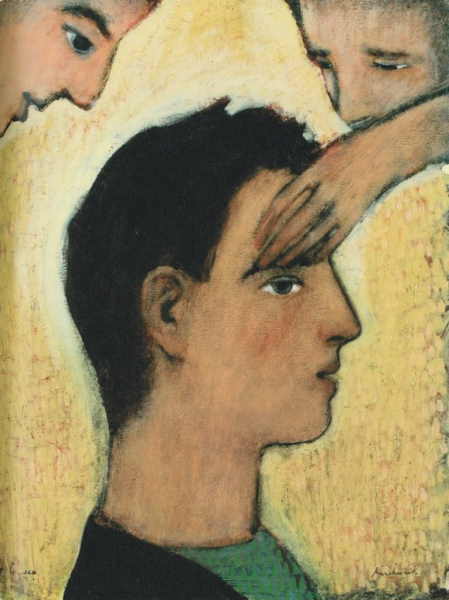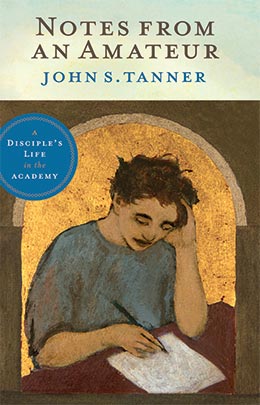Beehive and Portico
John S. Tanner, Notes from an Ameteur: A Disciple’s Life in the Academy (Provo, UT: Religious Studies Center; Salt Lake City: Deseret Book, 2011), 45–7.
We depend on vision - in our personal lives, in the Church, and at BYU... BYU is built on dreams as much or more as bricks and mortar. It exists first and foremost as an idea and ideal toward which we are strong.
 Helping to See. Brian Kershisnik. Jane's mother hear her piously proffering advice to her little brother: "Eat your carrots, John; they will give you good night vision." When her mother heard this she said, "That's right, Jane, do you know what 'vision' is?" "Of course I do, Mom," Jane said: "dreams from God." © 2009 by Brian Kershisnik. All rights reserved.
Helping to See. Brian Kershisnik. Jane's mother hear her piously proffering advice to her little brother: "Eat your carrots, John; they will give you good night vision." When her mother heard this she said, "That's right, Jane, do you know what 'vision' is?" "Of course I do, Mom," Jane said: "dreams from God." © 2009 by Brian Kershisnik. All rights reserved.
A stone beehive adorns the roof of the Maeser Building. It is a conspicuous feature of the building if you approach the upper campus from the west, the way BYU was originally laid out. As you come up the hill, you will see a carved beehive perched atop the Maeser Building’s columned portico. This stone beehive capped the original front porch of campus. It was a symbol of Deseret, a visible reminder of BYU’s pioneer past and Latter-day Saint identity.
The beehive sits atop an otherwise Neoclassical building, whose architectural vocabulary was intended to evoke such classical ideals as reason, harmony, authority, tradition, learning, and so forth. The design for the Maeser Building ultimately recalls ancient Greek temples. It was built during the Neoclassical Revival period, about a decade before the Lincoln Memorial. The original plan for the Maeser quad was loosely inspired by Jefferson’s design for the University of Virginia, only BYU’s quad was to be graced by an LDS temple opposite the Maeser Building.
To learn more about this history, I visited the display “Designing BYU” on the first floor of the Harold B. Lee Library. After visiting the exhibit, I decided to walk around south campus. My walk took me past the site of the home I lived in during my freshman year, now torn down and replaced with a lovely terraced garden. It was here, in the precincts of the Maeser Building, that college awakened me to the world of ideas. I used to like to study on the hillside, pleased to be in the historic part of campus near a building whose Doric columns and elegant architrave looked traditionally collegiate. Later I would teach civilization courses in this building, whose design bespoke the ideals of Western civilization we were studying.
The Maeser Building was also the site of early spiritual experiences. As I walked the once familiar path from my old home to the Maeser Building, my memory turned back to a fast Sunday in the spring of my freshman year. I was wrestling with the decision to serve a mission. I prayed as I walked the grounds, feeling the weight of a decision I knew was about much more than two years. It was about eternity. There, in the shadow of a stone beehive, I determined to stand in holy places and say, “This I believe. Here I stand.” [1]
To me, this juxtaposition of a beehive atop the entablature of a classical building serves as a visual reminder of BYU’s dual heritage and mission. The neoclassical architecture reminds me that BYU belongs within a venerable academic tradition stretching back to antiquity. We have inherited from ancient Athens and medieval Europe the idea of a university. This idea is signaled in the Maeser Building’s Neoclassical design. It articulates a noble aspiration: for BYU to take its place with other great universities as a place of deep learning and wisdom.
At the same time, the beehive reminds me that BYU also belongs within a specifically Latter-day Saint heritage, in which pioneers, out of their poverty and through their industry, established a house of learning in the desert at the behest of prophets and inspired by modern revelation. In adorning the Maeser Building with a beehive, the builders adopted iconography used to adorn the doors of the Salt Lake Temple. To become a house of learning that is worthy to be linked to sacred LDS houses of God—this too is a noble aspiration.
We who labor under the sign of the beehive atop a columned portico “have a double heritage which [we] must pass along: the secular knowledge that history has washed to the feet of mankind with the new knowledge brought by scholarly research–but also the vital and revealed truths that have been sent to us from heaven.” So President Kimball challenged BYU as it began its second century. [2] It is our duty at BYU, President Kimball continues, to become fully “bilingual,” speaking with “authority and excellence” the language of scholarship while becoming deeply “literate in the language of spiritual things.” Some doubt that BYU can do both well. These doubts are not new. Long ago Tertullian famously quipped, “What indeed does Athens have to do with Jerusalem, or the academy with the church?” [3] You provide tangible evidence to the contrary. You demonstrate in your daily lives that reason and revelation, study and faith, scholarship and sanctity can comfortably cohere in the souls of disciplined disciples. May we ever strive to embody the ideals symbolized by the Maeser’s columned portico and stone beehive.
Notes
[1] Martin Luther, as quoted in Roland H. Bainton, Here I Stand: A Life of Martin Luther (New York: New American Library, 1950).
[2] Spencer W. Kimball, “Second-Century Address,” delivered at Brigham Young University, October 10, 1975.
[3] Tertullian, Prescription Against Hereticks, trans. Joseph Betty, 1722.
